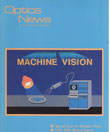
August, 1987 Issue
- Machine vision: the basics
- Image coding in the visual system
- Integrating vision-guided robots on the factory floor
- Speculations on unknown images, spectral sources, and physical constants
- Everything you ever wanted to know about standards
- Measuring the effective radiating temperature of the ozonosphere
- Browse all Issues
Feature Articles
Human operators just do not make good inspectors, regardless of how conscientious they may be.
by Valerie C. BolhouseImage coding in the visual system
In many cases, man-made image processing and analysis methods are designed to meet criteria from the visual system; in other cases, image processing methods have evolved independently from the visual system.
by G. BuchsbaumIntegrating vision-guided robots on the factory floor
If practical application of the technology does not become broadly based, opportunities and advancement in the field of vision systems and robotics will develop slowly.
by Terrence O'ConnellSpeculations on unknown images, spectral sources, and physical constants
In this paper, we are going to tackle a problem which, at first glance, appears akin to describing the sound of one hand clapping. This is the problem of describing in some way an image, when nothing is known about its structure. The image cannot be seen, and no prior information on its statistics are given. All that is known is that it is an array of energy flux values. Surprisingly, this quest will reach a definite (and positive) conclusion; it will also lead us along a road with numerous exits into related fields. Major detours will be made into spectroscopy and (surprisingly) cosmology.
by B. Roy FriedenEverything you ever wanted to know about standards
For the last several months we have been dealing with rather specific optical standards subjects. For a complete change this month, we feature a very general and weighty volume (some 575 pages) titled Standards Activities of Organizations in the United States (PB85-106151). This paperbound book [published in 1984 by the National Technical Information Service (NTIS), Springfield, Va. 22161; (703) 487-4650, costing $42.95, plus $3 for handling] lists just about anything anyone would ever want to know about federal, nongovernment, and state standards writing activities.
by Robert E. ParksMeasuring the effective radiating temperature of the ozonosphere
The experiment described this month represents a very clever application of radiation exchange. The center of the ozonosphere lies about 15 miles above the surface of the earth. In this discussion, we are not going into the photochemical reactions taking place in the ozonosphere, but instead shall focus on measuring its effective radiating temperature.
by J.H. Taylor

![Manual probe system with needles for test of semiconductor on silicon wafer. [A. Morozov / Getty]](https://opnmedia.blob.core.windows.net/$web/opn/media/images/articles/2025/1125/departments/202511-cover-web.jpg?ext=.jpg)
![Researcher Clara Saraceno in the lab. [Image by Carsten Behler Photography]](https://opnmedia.blob.core.windows.net/$web/opn/media/images/articles/2025/1025/departments/202510-cover-web.jpg?ext=.jpg)
